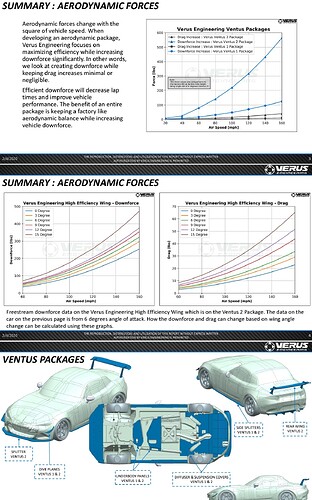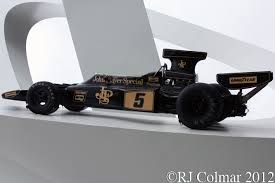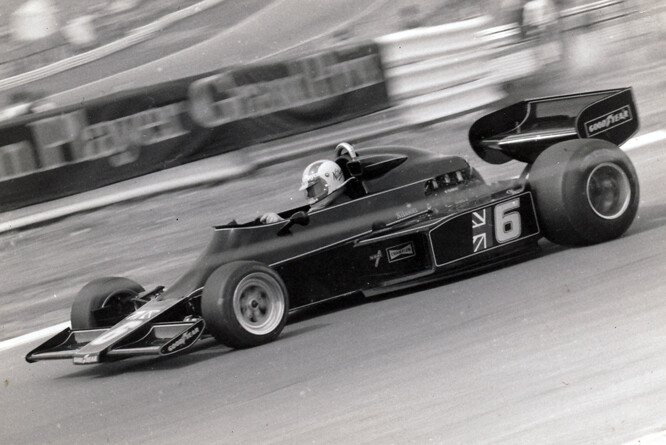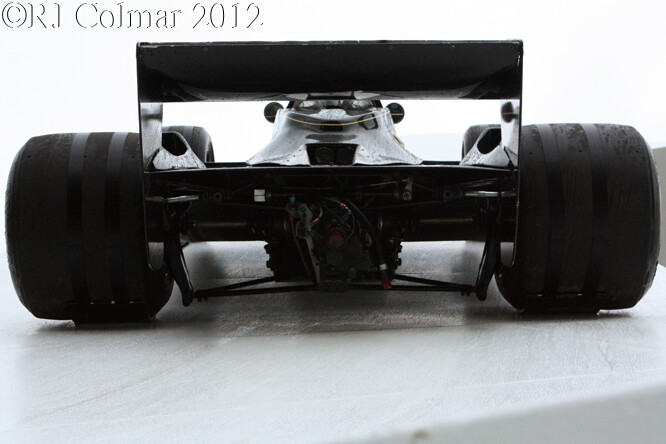Given a very smooth path, the airflow under the car is accelerated and has a reduced pressure compared with the flow over the top so is very effective in producing downforce.
It is so much more effective, though complex, to use the whole car body to generate downforce, than a wing. At 70mph, it is possible to create up to about 60kg of downforce per metre squared, so may be 10’s of kilos from a wing but 100s from the whole body.
It was the Lotus 77 which used upside down wing sections in the underside of the body to generate downforce.
The only company I know of to produce flat panels for the underside of the ND (and more) is Verus Engineering.
Yes, you are quite right and I was wrong, “Grip limit” defined as the g-force of the turn is only a function of the friction co-efficient of the tyre when considering weight changes. Aerodynamic down force, on the other hand, does increase the g-force limit, though I have read that tyre friction co-efficient decreases with increased contact patch pressure so a wider tyre helps.
However, I think changes in suspension stiffness or ARBs cannot change the total down force on the pair of outer tyres, only the distribution between front and back tyres, with a consequent effect on the distribution on the inner par of tyres, leading to the potential for much reduced grip on one tyre.
But the MX-5 should not be prone to this. It has an almost perfect 50:50 weight distribution front to back, plus almost identical spring rates all round, as well as a suspension geometry that maintains the wheel alignment.
Must admit I am a bit lost on this one. An aerofoil has a curved top surface so the laminar air flow flowing over it has further to travel so has to speed up (compared to the smooth laminar airflow underneath the flat underside) in order to catch up and prevent a vacuum where the airflows rejoin. The fact it has to speed up reduces the pressure compared to the underside creating lift. The original Audi TT is a case in point. The original had a very smooth curved upper surface compared to the underside which worked as an aerofoil causing lift at speed hence the well publicised high speed crashes. Audi had to use a spoiler/wing at the rear to stop this happening. Blue Algarve’s post shows that Ventus also use other aerodynamic features such as splitters, wings and rear diffuser etc to ensure this doesn’t happen. All I am saying is that you have to be very careful with what you are doing without the aid of a wind tunnel or CFD.
Thanks for the correction. Yes, it was the Lotus 77 ![]()
Wing down force of 45kg at 75mph, which is lift coefficient of about 0.6 from the wing. I am surprised they can do better, especially as the L/D is only 7. However, this proportion of down force all at the rear would not seem good for handing.
If the aerofoil is far from the ground, what you say is true. But the venturi effect of a nice smooth slot close to the ground changes the aerodynamics. however, it may not be enough to over come the top surface lift.
Also noting that the top side aerofoil shape is really messed up on a soft top MX-5, either by the abrupt rear window or by the slot effect of the open cockpit
However, this downforce/upforce is not uniform front to back. It is concentrated at the front, both from the underside and the top side. So it is possible to have a very “lift” backend; is the Audi problem?
Those Lotus inverted aerofoils were carefully positioned to keep the centre of the down force near the centre of the car.
Well that is certainly the case unlike the original Audi TT ![]()
I know L483LNA (Bruce) is no longer in your loving care but good to see it’s still on the road with over 222km on the clock and passing multiple MOTs with zero advisories. ![]()
Some good points you’ve made in your posts here, Steve, hopefully I can cover them all while I’m drinking my morning coffee!
This first point regarding ARB: Technically, I suppose you are right. The total downforce to the outer wheels does not essentially change, but it distributes weight to the inner wheels. This SHOULD increase overall traction as it brings the inner wheel side of the car down onto its wheels, decreasing both the chance that the outer wheels reach OVER their grip limit and that the inner wheels fall BELOW their grip limit. Regardless, if suspension is stiffened without the relevant AR considerations, you have reduced this beneficial effect, and, until the AR conditions are sufficiently met with stiffened springs, you will experience an abrupt downforce on the outer wheels while the inner wheels are effectively lifted, which results in relying on half of your surface contact area, which can only be a bad thing for traction. Furthermore, stiffened springs on a light car (especially driven at speed) on a surface that is not ideal will result in the increased inertia needing to be overcome for the suspension to travel smoothly over the surface, resulting in less surface contact area and thus less traction overall. I’m not trying to prove you wrong, I am just trying to clarify that my point is made with regard to stiffening springs, which can upset the balance that these cars come with that you so rightly point out. Perhaps a rather effective way to keep weight on the rear when it’s needed would be to stiffen only the front springs?
As for the geometry, ideally in high speed cornering, one would prefer the negative camber to increase somewhat, which I believe the MX5 does.
General point for ND’s aero:
The ND has a considerably higher rear deck than the previous models, which results in a shorter path for the air. I think if the ND’s aero was particularly bad, some panels would have been added by Mazda to the underside of the car, exhaust mods notwithstanding.
Another point to consider with the ND is that it is shorter, lower and wider, both in chassis and in wheelbase than certainly the mk1. This could be why it has been deemed “twitchy” as the wheelbase’s length to width ratio is now considerably shorter, which has upset the very natural handling feeling that the 5 always possessed. The ND is more responsive and steers quicker as it is, in fact I believe it now has electronic power steering? Could be wrong there, but certainly overall it requires more precise handling than earlier cars and can’t just be chucked about willy-nilly anymore!
I think you mean the Bernoulli effect, but I’m just nitpicking ![]() I think it is worth pointing out that the most aerodynamic shape is the teardrop, hence why most Porsches, until recently, had a very uniform appearance, trying to achieve the least drag. A rear spoiler would then be attached to slow down flow to the top of the car, and thus raise overall downforce. It seems to be that the ND (and to some degree the NC) has somewhat adopted this approach, although the teardrop on the ND is achieved with an upslope to the underside, which seems to be used to keep the top of the vehicle as short as possible to avoid the aerofoil effect. In theory, this reduces the need for a spoiler as the underside has been lengthened.
I think it is worth pointing out that the most aerodynamic shape is the teardrop, hence why most Porsches, until recently, had a very uniform appearance, trying to achieve the least drag. A rear spoiler would then be attached to slow down flow to the top of the car, and thus raise overall downforce. It seems to be that the ND (and to some degree the NC) has somewhat adopted this approach, although the teardrop on the ND is achieved with an upslope to the underside, which seems to be used to keep the top of the vehicle as short as possible to avoid the aerofoil effect. In theory, this reduces the need for a spoiler as the underside has been lengthened.
So, this begs the question: will the panels underneath effectively shorten the path of airflow and be ineffective, or will they speed up the airflow and create more negative pressure? I am always dubious to accept the graphs put out by a company who are trying to sell you a product, since nowadays it is incredibly easy to demonstrate your proof through videos and photographs, whether it be in a wind tunnel or on a track.
Another point worth considering, which I pointed out in I think my very first post in this thread, is that the ND is not a sophisticated car when compared to brands like Lotus. I’ve since found out that in fact the ND has upgraded to aluminium control arms and one or 2 other suspension components, but adjusting to inflation the ND is a considerably cheaper car than mx5’s were in the 90’s. Mazda probably knows that some underpanelling would do the car wonders, but has left that to individual owners to shell out for, as they have always done in regards to sporty mods, to keep overall costs down.
Overall, aerodynamics is a tricky and sometimes unintuitive game. Something can look great in a wind tunnel, but suddenly lose all of that benefit over a bump at high speed and other road conditions, when cornering, braking or even accelerating. The footage is out there of dramatic aero fails. I’m not saying a humble mx5 could flip itself over, but how much expense is really worth it to be able to take a corner on a public road at 80mph over 70?
I think I’ll reply bit by bit.
I think you are a bit to hung up on the distance the air flows. This is an “explanation” often used by us aerodynamicists to explain lift on an aerofoil but in reality it is all due to the balance of a number of fluid dynamic relations. Just think about an uncambered aerofoil. The distance from LE to TE is same top and bottom, but if you incline the aerofoil, the flow no longer attaches at the LE, “making” the distance over the low pressure side longer. In fact, the flow travels so fast over the top that particles arrive at the trailing edge sooner than those taking the slow route, inducing a shear layer in the wake.
In a constant turn, the cornering, horizontal force from the tyre contact patches applies a rolling moment around the vehicle CoG, which is countered by the changes in the vertical forces at the contact patches. Because the total vertical force has to remain equal to the weight of the vehicle, the increase in force on the outer two tyres must be equal to the decrease in force on the inner two tyres. So the suspension arrange can not make any difference in the downforce on the outer pair or inner pair of tyres. The ARBs cannot change the down forces on the tyres; they cause the inner suspension units to compress in tune with the outer units.
Of course, the distribution between front and rear tyres cannot be statically determined so the suspension can make a difference to the fore aft distribution.
While I have nothing to add on the subject of MX-5 vehicle dynamics being dicussed here I hope you will excuse a little pedantry on Lotus types so we are all on the same page …
Correct the Lotus 72 raced from 1970 - 1975 had a flat bottom, with downforce generated from front and rear wings, mostly triple plane at the back in 1970 to full banana at the back 1974/5, no side skirts.
Incorrect the Lotus 77, was known originally as the adjustacar with inboard front brakes, had a flat bottom including the side pods. As the 1976 season progressed the inboard front brakes were ditched and the side pods, that originally swept back to the rear wheels from roughly the rear bulkhead where it meets the engine, grew in length to end up starting halfway along the cockpit.
Around this time Lotus, McLaren, Penske and others started playing around with skirts, made from Lexan or similar materials with a view to lowering air pressure under their cars.
It was the Lotus 78 introduced in 1977 that featured side pods with upside down aircraft wing profiles to generate downforce. IIRC Colin Chapman mentioned the inspiration for the profiles came from a de Havilland aircraft at the time, he had ofcourse employed a number of ex de Havilland personel over the years.
… and of course it was the Lotus 79 introduced in 1978 that was the first F1 car to go to full venturi.
Hope that helps.
Correct, my mistype!
two things I notice: totally flat bottom to the car, until the rear wheel axles, but then the fairing is missing. And they reckon he lost it on the crest. If the car was light or flying, the aero downforce from the lower surface disappears quickly, to be replaced by lift.
And this one catches the moment!
Also at 190mph, a tonne of lift only requires a lift co-efficient of 0.3.
Tyre grip (friction) always increases with increasing weight or downforce on the wheel, but it is not proportional to weight, friction co-efficient drops as the contact pressure increases.
As the transfer of weight from inside to outside wheels is dependent on the ratio of the height of the CoG to the width of track, essentially the maximum cornering G for a given set of tyres is limited by that ratio. The friction on the outer tyres goes up less than the friction on the inner tyres go down. This is made even worse if the suspension cannot keep the tyres upright.






